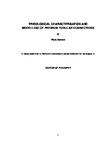TRIBOLOGICAL CHARACTERISATION AND MODELLING OF PREMIUM TUBULAR CONNECTIONS
| dc.contributor.supervisor | Le, Huirong | |
| dc.contributor.author | Stewart, Fiona | |
| dc.contributor.other | Faculty of Science and Engineering | en_US |
| dc.date.accessioned | 2014-11-11T10:45:36Z | |
| dc.date.available | 2014-11-11T10:45:36Z | |
| dc.date.issued | 2014 | |
| dc.identifier | 10359388 | en_US |
| dc.identifier.uri | http://hdl.handle.net/10026.1/3162 | |
| dc.description.abstract |
Premium tubular connections (sometimes referred to as rotary shouldered thread connections), are commonly used to complete a production string in a well in the oil and gas industry. These are attached to threaded pipe ends using a bucking unit and a pre-defined torque value. The torque value is calculated using the coefficient of friction between the two surfaces and a well-known torque equation. The existing technology relies on the coefficient of friction approximated by interpolation, or extrapolation, of empirical data. This may become inaccurate due to the variation of surface finish and/or operation conditions and lead to over or under torque of the connections. A failure such as a leaking connection can result in high financial implications as well as environmental ones. The project was aimed to develop a bench test which adequately represents field conditions. This benchmark test was then used to investigate how CoF was affected by changes in the main variables so that these variables can be better controlled. Therefore, a propriety laboratory test system was developed to allow measurements of friction and galling under these conditions and to examine the sensitivity of friction to initial surface topography, contact pressure, sliding speed and lubricant type. Samples were produced to represent variables which were possible within the oil and gas industry. A set of data was produced to identify the different frictional values for each combination of variables. The results showed that the initial surface topography and the burnishing in repeated sliding have significant effects on friction. iv In order to understand the correlation between the effects of initial surface roughness and burnishing during the sliding process on the coefficient of friction, a theoretical approach was taken to produce a mathematical model whichutilised the data from the laboratory testing. This gave predictions of the wear, roughness and friction with sliding distance. This data was then compared to the physical testing and found to be in line with the results. The results helped to understand how friction is related to external circumstances in the operation of premium tubular connections. | en_US |
| dc.description.sponsorship | Hunting Energy Services | en_US |
| dc.language.iso | en | en_US |
| dc.publisher | Plymouth University | en_US |
| dc.title | TRIBOLOGICAL CHARACTERISATION AND MODELLING OF PREMIUM TUBULAR CONNECTIONS | en_US |
| dc.type | Thesis | |
| plymouth.version | Full version | en_US |
| dc.identifier.doi | http://dx.doi.org/10.24382/4060 |
Files in this item
This item appears in the following Collection(s)
-
01 Research Theses Main Collection
Research Theses Main


